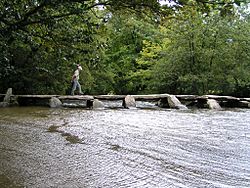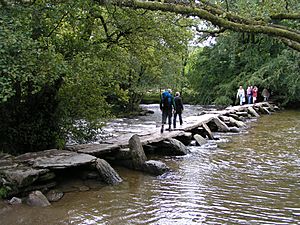Tarr Steps facts for kids
Quick facts for kids Tarr Steps |
|
|---|---|

Tarr Steps viewed from upstream
|
|
| Coordinates | 51°04′37″N 3°37′05″W / 51.077°N 3.618°W |
| Crosses | River Barle |
| Locale | Exmoor National Park, Somerset, England |
| Characteristics | |
| Design | clapper bridge |
| Material | stone slabs |
| Total length | 55 metres (180 ft) |
| Number of spans | 17 |
The Tarr Steps is a really old and special bridge in Exmoor National Park, England. It's a unique type of bridge called a clapper bridge. This bridge crosses the River Barle and is found inside a beautiful nature reserve. It's near the villages of Withypool and Dulverton.
Clapper bridges are built in a simple, ancient way. Experts believe Tarr Steps might be from the Middle Ages. It's made from huge stone slabs, some weighing as much as two cars! The bridge is about 55 meters (180 feet) long and has 17 sections. It's so important that it's protected as a Grade I listed building and a Scheduled Ancient Monument.
Contents
Exploring the Nature Reserve
The land around Tarr Steps is a special place called the Tarr Steps Woodland National Nature Reserve. It's looked after by the Exmoor National Park. This reserve covers about 33 hectares (81 acres) of the River Barle valley.
Woodland and Wildlife
The woodland here is mostly made up of sessile oak trees. You can also find beech, ash, sycamore, and hazel trees. On the ground, you might spot blackberry bushes, bluebells, and honeysuckle. This area is very important for tiny plants like mosses, liverworts, and lichens. They love the cool, damp weather here.
Long ago, people used to cut the trees in a special way called coppicing. This helped them get wood to make charcoal for the local iron industry. The river and its woodlands are part of the Barle Valley Site of Special Scientific Interest. This means they are very important for nature. You can see lots of wildlife here, from large red deer to tiny dormice. Rare animals like the Barbastelle Bat and otter also live here. They feed along the clean, fast-flowing river.
Walking Paths and Facilities
There are clear walking paths along the valley. You can walk between Simonsbath and Dulverton, or to the village of Withypool. A popular walk starts from the main car park for Tarr Steps. You can walk down to the river, follow the riverbank for about 1.3 kilometers (0.8 miles) to a footbridge, and then cross back over the clapper bridge.
The main car park and toilets are about 400 meters (1,300 feet) from the bridge. You can reach them from the B3223 road. If you have a disability, there's parking closer to the bridge. You can also find refreshments and information panels there. These panels, put up by the Exmoor National Park, share interesting facts about the bridge's history and how it was built.
The Ancient Bridge
Tarr Steps is a Scheduled Ancient Monument found within the nature reserve. It's a special type of bridge called a clapper bridge. The name "clapper bridge" comes from an old Latin word meaning "pile of stones." These bridges are built using large, flat stones stacked on top of each other without any mortar (like cement). Tarr Steps is the biggest clapper bridge of its kind.
Bridge Design and Size
The bridge has 17 sections and stretches about 50 meters (164 feet) across the river. The top stone slabs weigh between one and two tons each. They are about 99 centimeters (39 inches) above the normal water level. The largest stone slab is over 2.4 meters (8 feet) long and about 1.5 meters (5 feet) wide. This makes Tarr Steps one of the most famous landmarks in Exmoor.
Age and History
No one knows exactly how old Tarr Steps is. Some people think it dates back to the Bronze Age, which was thousands of years ago. Others believe it was built around 1400 AD. The bridge has been repaired many times, especially after floods. Each time it gets damaged, it shows how strong the flood was.
Some of the top stone slabs have been washed away by very strong floods. Now, all the stones are numbered. This makes it easier to put them back in the right place after a flood. The Exmoor National Park website explains that the stones can be washed up to 50 meters (164 feet) downstream!
Protection from Floods
A special feature of Tarr Steps is the way some slabs are angled against the ends of each pier. This helps to break the force of the river's current. It also helps to push away floating things like branches. Even with this design, many times the damage has been caused by debris hitting the bridge during floods.
In the past, local farmers used to clear the debris once a year. But after a big flood in 1952, cables were placed across the river upstream. These cables help to catch branches and other debris before they can hit the bridge.
Recent Flood Damage
Despite these efforts, the bridge was badly damaged by floodwater on December 22, 2012. Strong currents broke the steel wires upstream, and fallen trees washed down the river. On November 21, 2016, floodwaters carried away part of the bridge again. Luckily, it has been rebuilt since then.


